Loggerhead Shrike and waning SuperMoon:
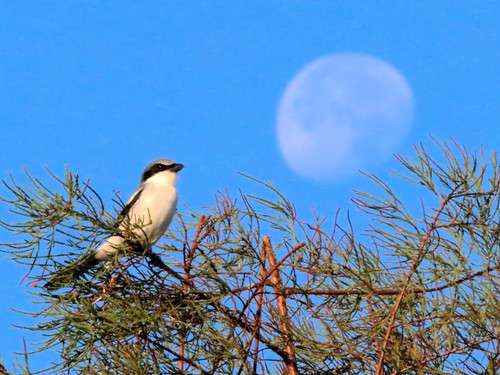
A murky morning on the local wetlands:
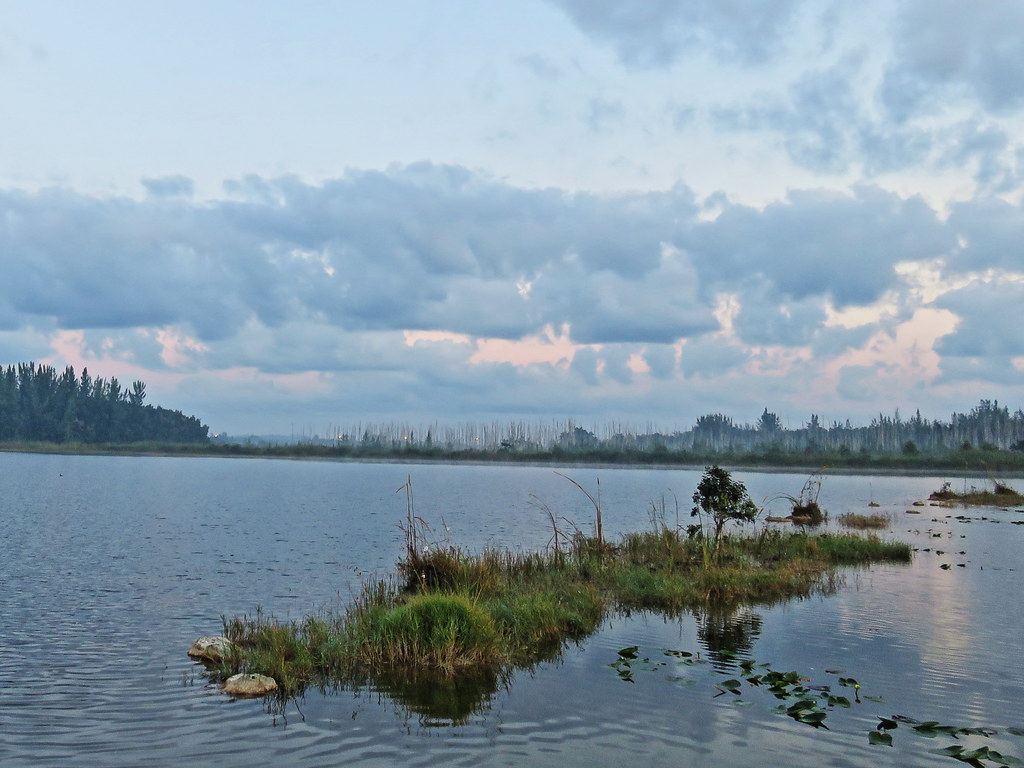
Around the world there are thirty shrike species, but the Loggerhead Shrike is the only whose range is limited to North America.
The population of this species has declined dramatically since the mid-Twentieth Century, believed to be attributable to human alteration of habitat such as elimination of fence rows in its favored open pastures and their replacement by cropland. Other factors may include the effects of pesticides, strip mining and expanded dense urbanization. It is listed as threatened or endangered in several Midwestern States.

 The hooked beak and striking plumage pattern of the Loggerhead Shrike make the little bird look fierce indeed.
The hooked beak and striking plumage pattern of the Loggerhead Shrike make the little bird look fierce indeed.
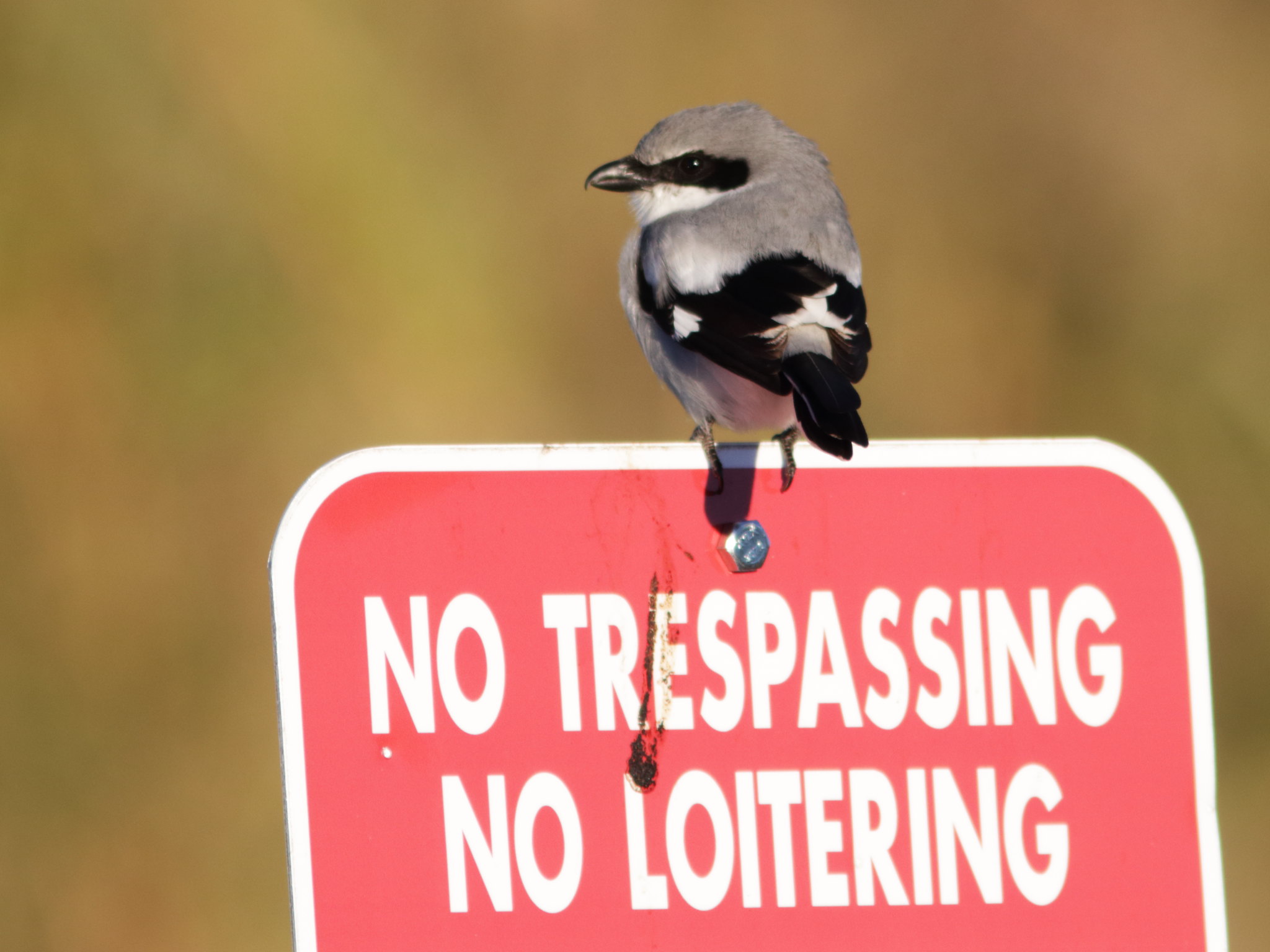
![]()
When I was about 10 or 11 years old (before I started my Birding Life List at the age of 13), while walking in the river bottoms near my home in New Jersey, I came across a barbed wire fence which had a mouse and several grasshoppers impaled on the spikes. I already knew from my reading that this is a practice of shrikes. It allows them to secure and tear prey despite their lack of talons. I returned to look for the shrike and finally saw it.
Here in south Florida, as in the southern half of the contiguous 48 States, it is found all year around. It also breeds up through the western central US into Canada, but migrates south in winter.
A courting pair:
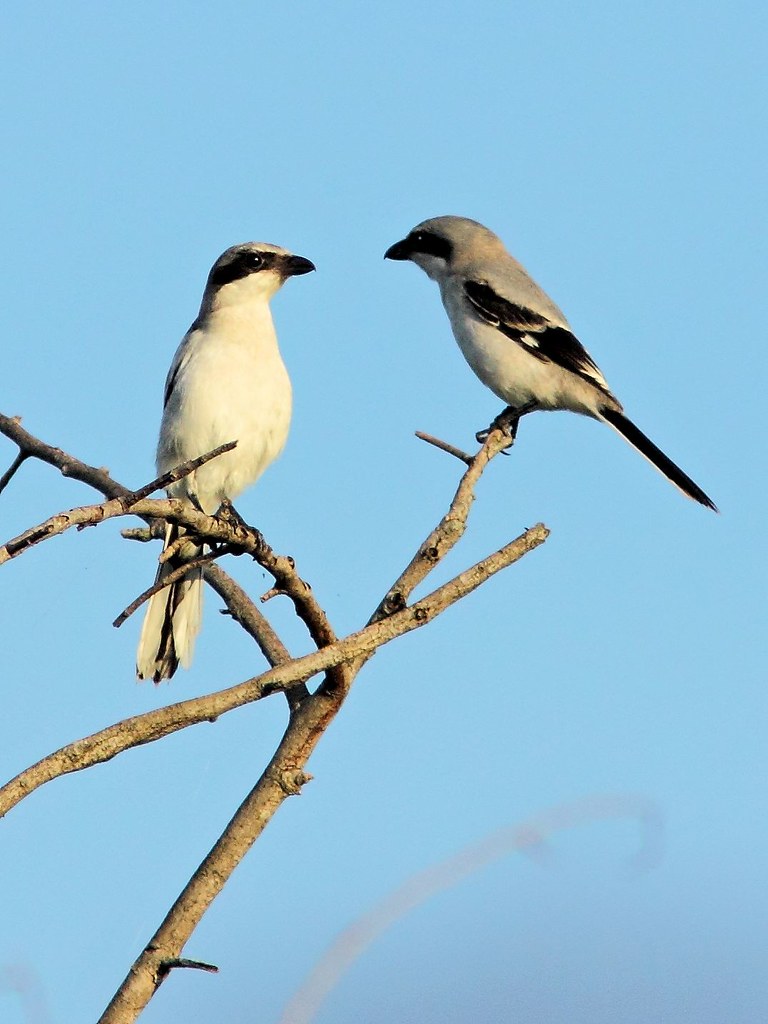
I usually see one or a few on my daily morning walks, and they often forage in our suburban neighborhood.
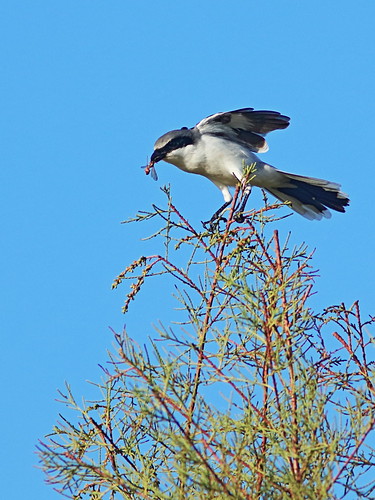
A few times over the years a shrike would fly down and pick up a prey item near where I was standing. The large grub in the second photo below is probably the larva of a Horsefly:

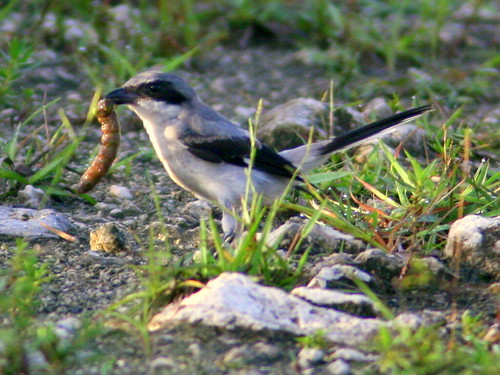 I thought this to be a random occurrence until one day while walking along the path I noticed that, after it plucked an insect near me, it continued to follow me along, flying from one perch to the next. Once again, it flew down behind me and seized an elongated prey item. I was not sure whether it was an insect or a small lizard or snake.
I thought this to be a random occurrence until one day while walking along the path I noticed that, after it plucked an insect near me, it continued to follow me along, flying from one perch to the next. Once again, it flew down behind me and seized an elongated prey item. I was not sure whether it was an insect or a small lizard or snake.
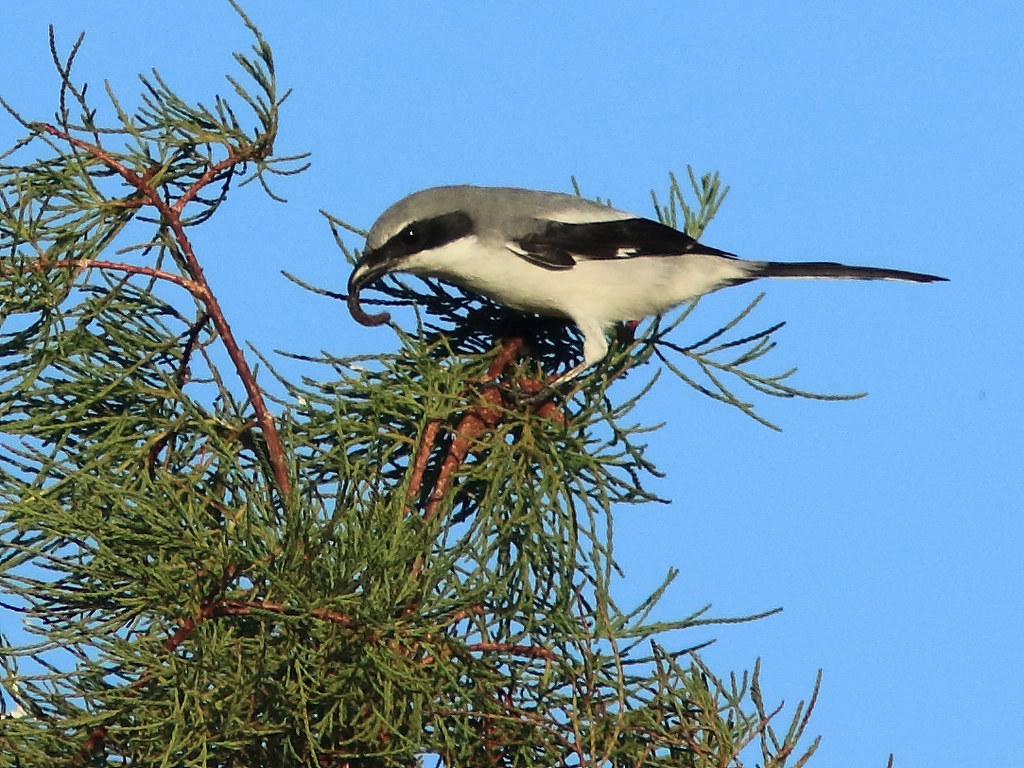
The shrike likely learned that my walking along the path often frightened some grasshopper or other creature out into the open. When I lived in Dallas the mockingbirds often followed me as I mowed the lawn, surely for the same reason. Similarly, gulls follow boats, and inland, the plow.
I watched for this behavior and it was repeated by the shrikes on other occasions. The shrike sometimes moved along behind me for several yards but I did not see it fly down. Once a shrike picked up a butterfly which flew up from my feet and landed several yards away. It was a Gulf Fritillary, and I photographed it. Just as I lowered the camera the shrike snatched it and flew into a nearby bush. A missed photo-op!

It seemed to take a bite and then immediately dropped the butterfly. It must have tasted horrible, as it shook its head and cleaned its bill.
This observation led me to research the dietary habits of Loggerhead Shrikes and discover that they may impale prey which contain toxins, such as the Monarch butterfly, leaving them for 3 or more days and then "...consuming them afterward, presumably after poisons have degraded... In addition, regularly impales lubber grasshoppers (Romalea guttata) in peninsular Florida for 1–2 days, and then feeds on head and abdomen, discarding thorax which contains poison glands" REF: Birds of North America, Cornell Laboratory of Ornithology [Subscription required].
It is not clear whether this behavior is innate or learned from unpleasant experiences such as the episode which I witnessed. Indeed, larvae of the Gulf Fritillary accumulate toxins from host plants such as passion vine or manufacture them in their own bodies. Adult butterflies also release noxious chemicals from glands in their abdomen when disturbed, to deter predators such as birds. REF: Beautiful but stinky: Gulf Fritillary
= = = = = = = = = = = = = = =
Linking to Misty's CAMERA CRITTERS,
Linking to Eileen's SATURDAY'S CRITTERS,
Linking to SKYWATCH FRIDAY by Yogi, Sylvia and Sandy
Linking to WEEKEND REFLECTIONS by James
Linking to BirdD'Pot by Anni
Linking to Our World Tuesday by Lady Fi
Linking to Wild Bird Wednesday by Stewart
Linking to Wordless Wednesday (on Tuesday) by NC Sue
Linking to ALL SEASONS by Jesh
________________________________________________
Please visit the links to all these memes to see some excellent photos on display
________________________________________________
The Purple Gallinule is a Florida favorite. It was one of those species in my bird book whose picture looked so exotic and which, as a kid in New Jersey, I hoped one day to see. It took a while, but I finally set eyes on one in Avery Island, Louisiana, in 1967. Here in south Florida it is easy to find them in the right places, especially the settling ponds at water treatment plants such as Green Cay Wetlands in Boynton Beach:

This is the nature center and beginning of the boardwalk at Green Cay:
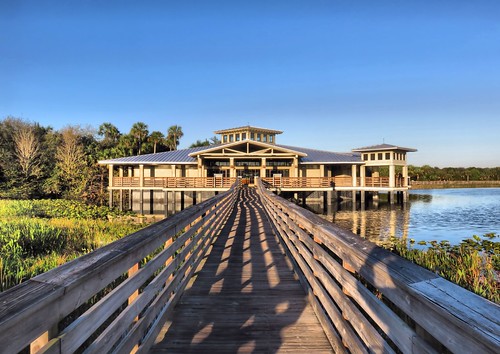
Peaceful Waters Park in Wellington is another such location. Here a Purple Gallinule shows off its long toes which allow it to walk across the floating vegetation:

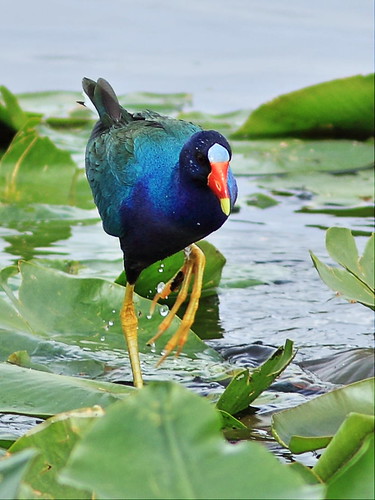
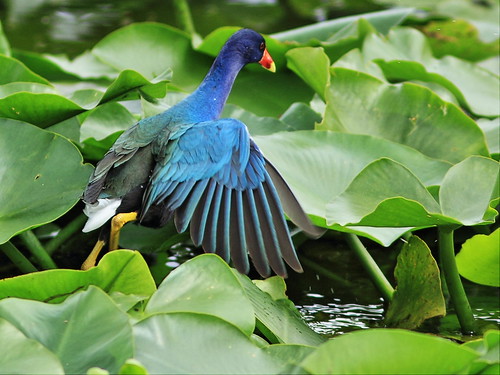
The juvenile can be rather drab. This one was at Loxahatchee National Wildlife Refuge in Palm Beach County:
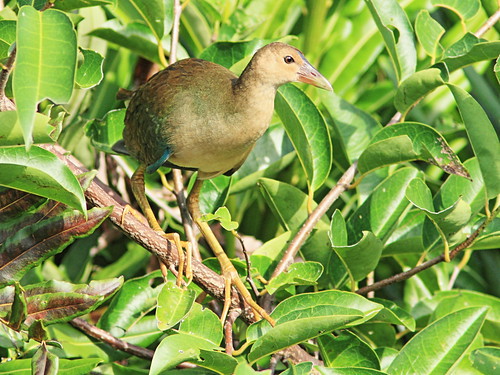
The first time I saw this species in our neighborhood Wounded Wetlands was in January, 2015, when a pair showed up. I hoped the pair would breed, but they disappeared after only a week or so:
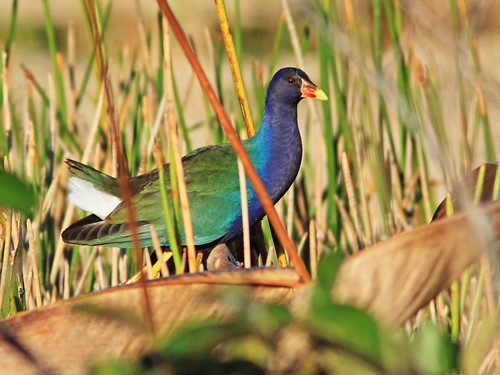
One year later, also in January, a single adult Purple Gallinule appeared in the same location. Try as I did, I could not find a second bird. It remained into March:

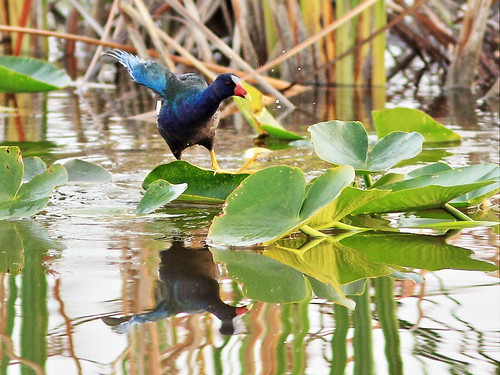
This December I saw a juvenile gallinule in the same local wetlands patch. The light was bad and it was rather secretive, so at first I was not sure of its identity. I patiently waited for it to come out into the open. It was eating the flowers and seed of Alligator Flag:
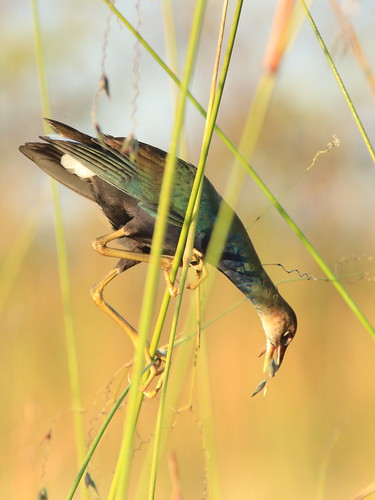
Alligator Flag must have its roots in water most of the time, so it is found on the edges of marshes and other persistent bodies of water. In the Everglades, this plant often signals the presence of an alligator hole.

The tiny flowers of Alligator Flag rise high above on slender stems and the only way the bird can get up to them is to gather several stalks in each of its huge feet and take advantage of the construction principle of triangulation (the use of triangular shapes to give stability to structures such as buildings and towers-- the Eiffel Tower is a good example). In good light, the beauty of this immature Purple Gallinule is revealed. I love this striking pose:
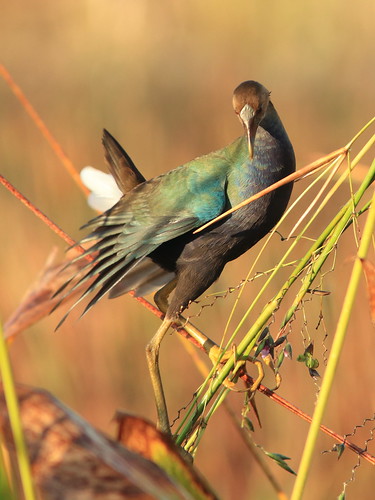 = = = = = = = = = = = = = = =
= = = = = = = = = = = = = = =
Linking to Misty's CAMERA CRITTERS,
Linking to Eileen's SATURDAY'S CRITTERS,
Linking to SKYWATCH FRIDAY by Yogi, Sylvia and Sandy
Linking to WEEKEND REFLECTIONS by James
Linking to BirdD'Pot by Anni
Linking to Our World Tuesday by Lady Fi
Linking to Wild Bird Wednesday by Stewart
Linking to Wordless Wednesday (on Tuesday) by NC Sue
Linking to ALL SEASONS by Jesh
________________________________________________
Please visit the links to all these memes to see some excellent photos on display
________________________________________________
Mary Lou and I like to get out about a half hour before sunrise. It is usually cool and the winds are calm. On January 8 the morning weather report caused us some concern, but the radar looked clear and we set out with an eye on the sky. The third-quarter Super-moon was almost directly overhead.
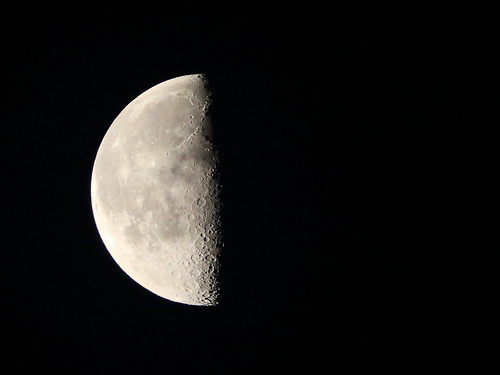
About ten minutes before sunrise we reached the lake. The sky had lightened up a bit but the opposite shore was still quite dark:
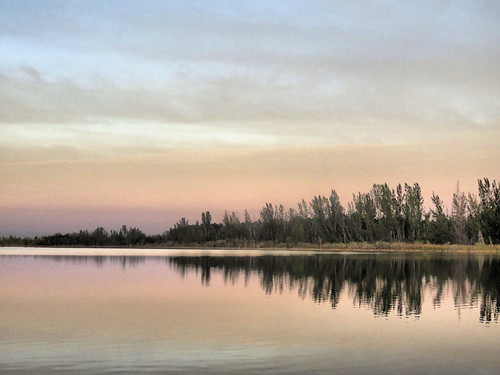
The diffuse light reflected on the still water as a Great Egret explored along the shore:
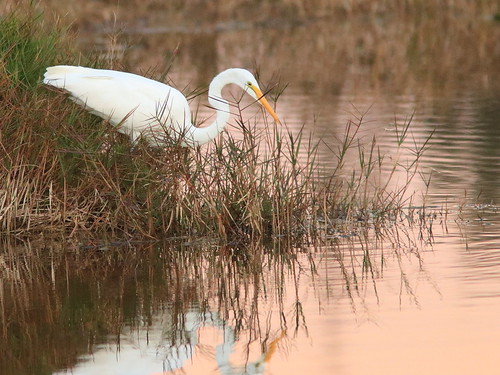
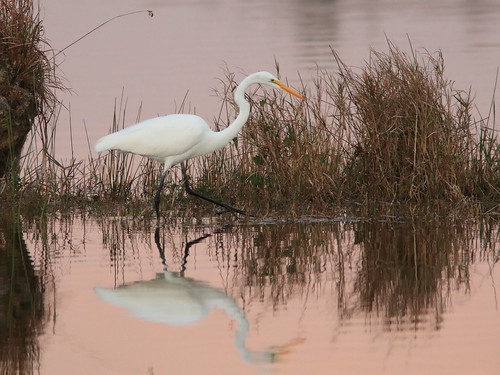
The sun reflected on a backdrop of high clouds to the west:
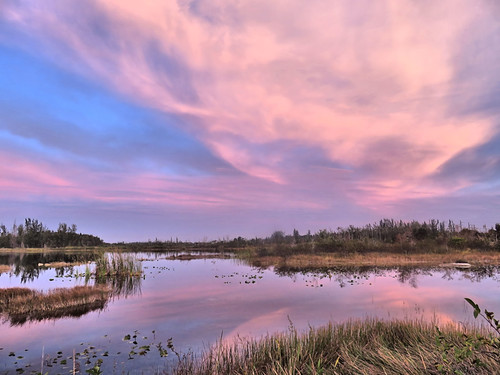
A large alligator moved lazily along, barely creating a wake:
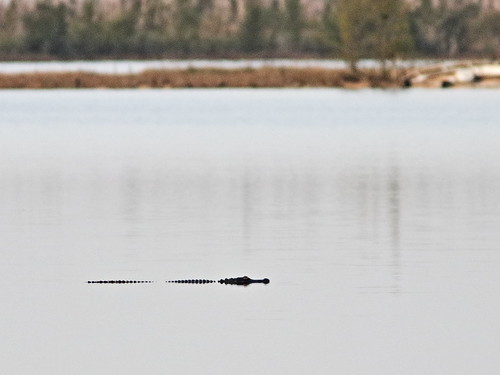
Preoccupied with the alligator, I must have missed seeing a Bobcat as it crossed the road about 100 yards to the north. I snapped a few shots before it disappeared in the brush to the left:

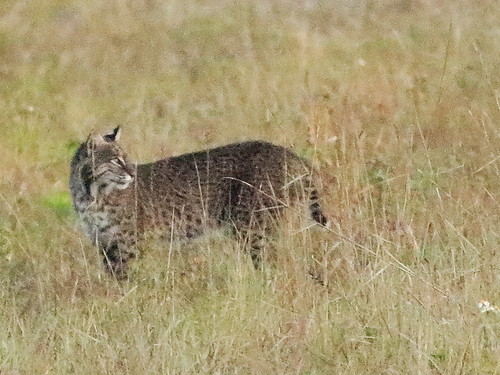
I started to move quietly along in hopes of seeing the cat as it proceeded towards the lake, but it surprised me by suddenly running back across the road at a full gallop. In the space of only two seconds I shot a volley of 6 photos. All were poorly focused, so to make up for the lack of clarity I stitched them together to impart a sense of motion (click on image to enlarge):

I proceeded to the heron rookery, which is about another half mile beyond the lake. Hurricane Irma had pushed down nearly all the larger trees along the canal. Many were still alive and leafed out, their crowns protruding into the canal.
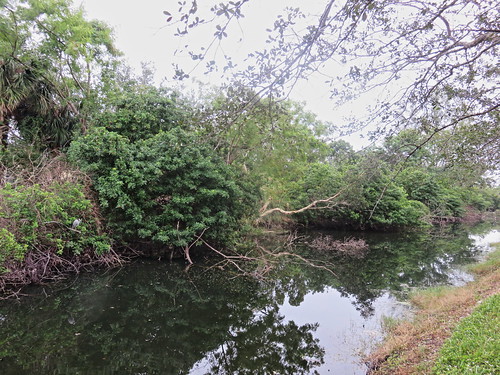 This seemed to be favorable for the herons, as the count has climbed from one to a dozen in the past few weeks. This morning I counted 7 adult and 2 immature Yellow-crowned Night-Herons. Some were already developing breeding plumage-- the top of their heads had lost the streaks and were turning to gold, their black legs showed brighter yellow color, and their nuptial plumes had emerged:
This seemed to be favorable for the herons, as the count has climbed from one to a dozen in the past few weeks. This morning I counted 7 adult and 2 immature Yellow-crowned Night-Herons. Some were already developing breeding plumage-- the top of their heads had lost the streaks and were turning to gold, their black legs showed brighter yellow color, and their nuptial plumes had emerged:

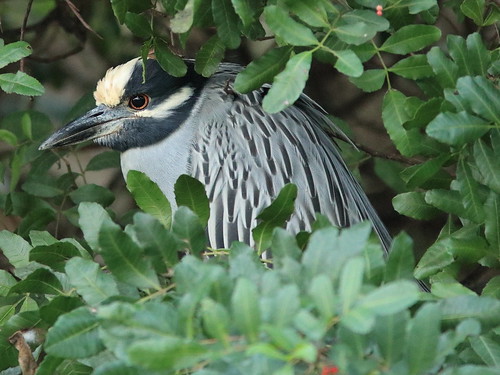

Immature Yellow-crowned Night-Heron:
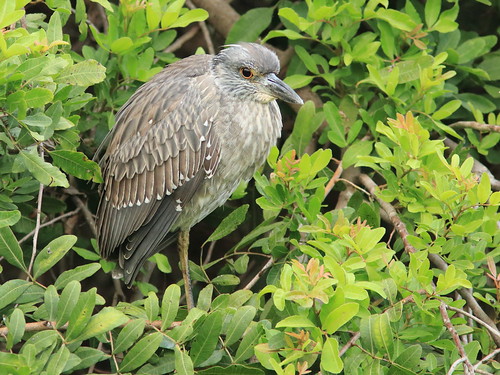
At least two Black-crowned Night-Herons have also been present, though they are more secretive and I did not find them this morning. This is the adult:
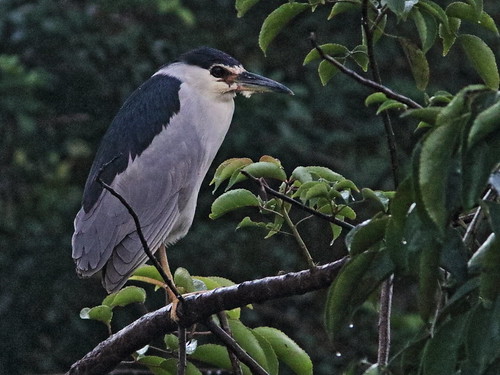
At least one immature Black-crowned Night-Heron often roosted with the adult. Note that its bill is partly yellow and it lacks the fine spotting of the immature Yellow-crowned species:
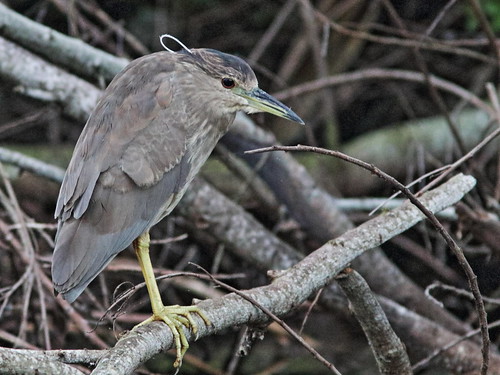
The sky to the north indicated that the predicted storm front was approaching, but it seemed to be moving slowly, so I started back at a leisurely pace. Mary Lou was already home.
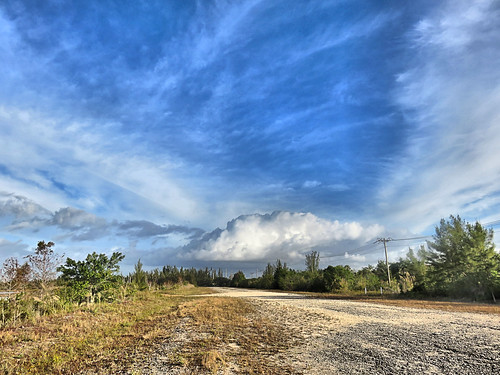 I stopped to photograph another Great Egret as it foraged in a lakeside marsh along with a pair of Mottled Ducks. Fish are trapped in the marsh as it dries up, and it becomes a rich food source. The female Mottled Duck subsists largely on fish and crustaceans during breeding season, so it must benefit from its association with the egret:
I stopped to photograph another Great Egret as it foraged in a lakeside marsh along with a pair of Mottled Ducks. Fish are trapped in the marsh as it dries up, and it becomes a rich food source. The female Mottled Duck subsists largely on fish and crustaceans during breeding season, so it must benefit from its association with the egret:
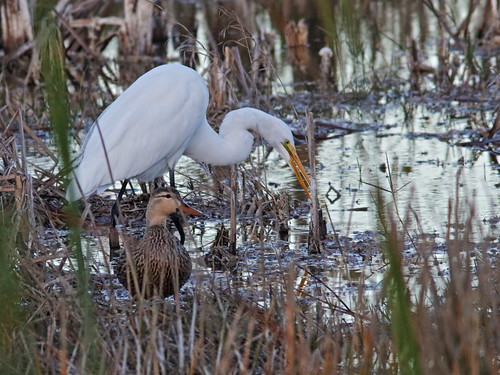

Other subjects along the way home were a Red-bellied Woodpecker...
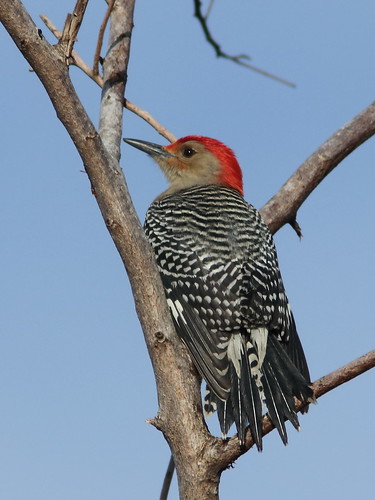
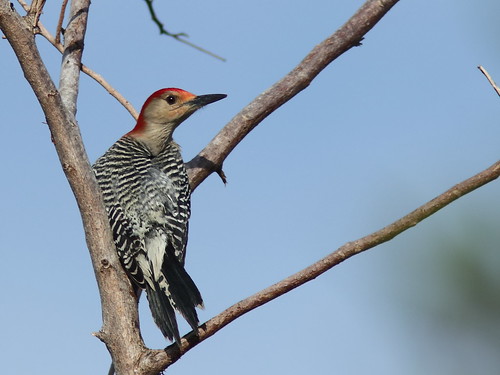
...a European Starling...
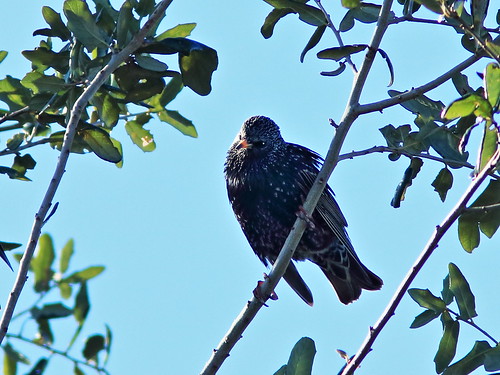
...and an American Kestrel:

Light rain started falling and I had to cover my camera and hurry back to the house!
= = = = = = = = = = = = = = =
Linking to Misty's CAMERA CRITTERS,
Linking to Eileen's SATURDAY'S CRITTERS,
Linking to SKYWATCH FRIDAY by Yogi, Sylvia and Sandy
Linking to WEEKEND REFLECTIONS by James
Linking to BirdD'Pot by Anni
Linking to Our World Tuesday by Lady Fi
Linking to Wild Bird Wednesday by Stewart
Linking to Wordless Wednesday (on Tuesday) by NC Sue
Linking to ALL SEASONS by Jesh
________________________________________________
Please visit the links to all these memes to see some excellent photos on display
________________________________________________
Again, I am looking back three years, searching for images which depict some of my favorite memes: Critters of all kinds, beautiful skies and reflections, changes of the season, and scenes which speak for themselves. My archives for January, 2015 include over 600 processed photos.
Unsettled sky and a colorful sunrise over our local wetlands on January 11:

You may recall that during the previous month a new young female Bald Eagle appeared with the local male (Pride) who had lost his mate (Joy) back in October, 2014. We watched the nest carefully for signs that she might start breeding. As I noted last month, Jewel seemed to lack an instinct to sit on the nest, while Pride often occupied it and continued to add sticks.
On January 1, 2015 the nest was in excellent shape due to Pride's efforts, but it remained empty most of the time during the next few weeks.
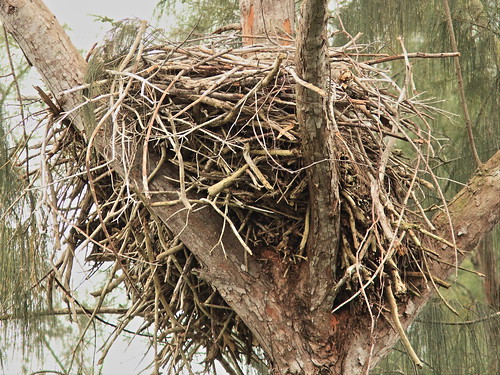
Facebook eagle lovers named the new female "Jewel." She often flew off alone and we worried whether the pair would ever develop a strong bond. I encountered Jewel in the wetlands southeast of the nest. The dark streaks on her head and dark tail feather tips are signs that she has not yet reached full adult plumage:

This is a composite image as Jewel landed on a small tree and then flew off:

The Bald Eagles in south Florida usually lay their eggs in December and by late January are already tending to their nestlings. As the month progressed this pair spent more time together, and on January 28, just after I arrived at the nest site, we saw Jewel fly in from the west to the nest area. She was carrying a good sized fish that looked like a shad. She circled with it and ended up roosting on top of a Melaleuca snag to the west of the nest. She proceeded to eat the fish.
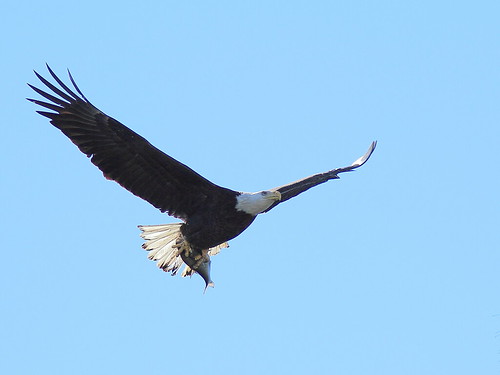

About 10 minutes later, Pride flew in from the SW carrying a small fish. He roosted on an adjacent snag slightly above the female. Both kept eating until the female finished. Then the male flew down and they copulated for about 1 minute 10 seconds.
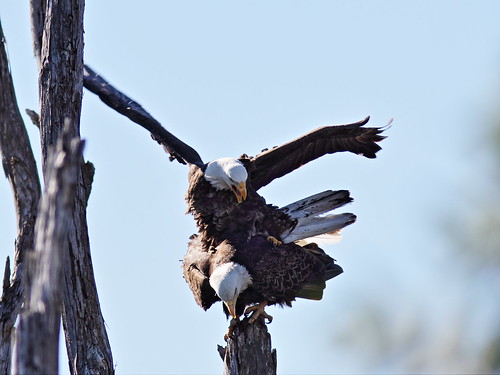
It appeared to be a successful mating, unlike some the brief attempts that had previously occurred. Pride then roosted briefly before flying off. Jewel remained on the roost

He soon returned carrying a small stick, and Jewel promptly joined him in flight. Both circled over the nest area and then disappeared high and to the south. To be continued next month...
Every morning before sunrise we try to escape to the relative solitude of our Wounded Wetlands. Here is Mary Lou walking out before sunrise under the Wolf Moon on January 5. (This year, 2018, we can look forward to two SuperMoons in January-- the second will be a "Blue Moon.")
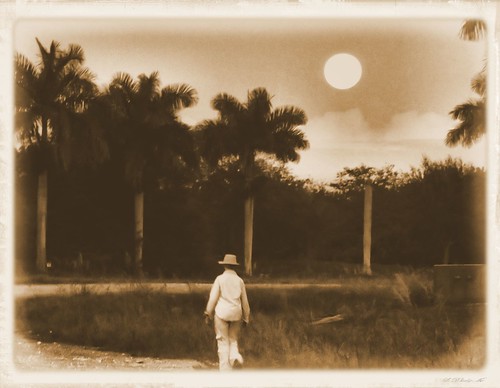
On a calm morning, a Little Blue Heron lifts off:
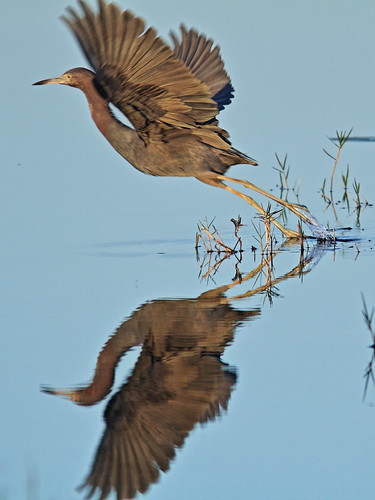
A brace of Mottled Ducks flies over the lake. The male has a bright yellow bill while that of the female is mottled orange:

In the rookery, I find only one Yellow-crowned Night-Heron:
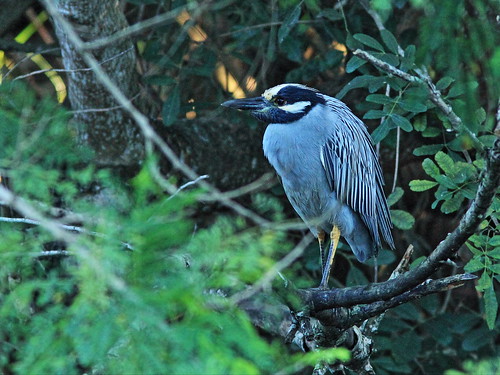
Back home, in late afternoon, the view from our patio exhibits all the "me too" fences required by our homeowners' association:

A Great Blue Heron poses next to a neighbor's fence:
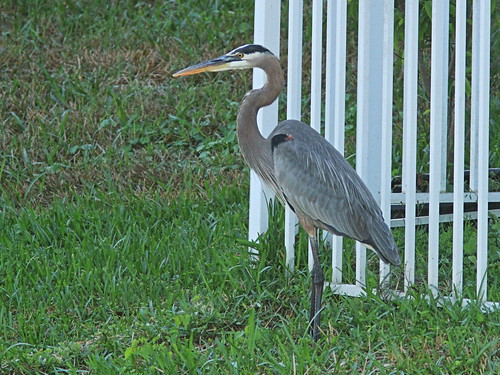
A Double-crested Cormorant dries its wings as it stands on the duck decoy which floats our irrigation water intake:
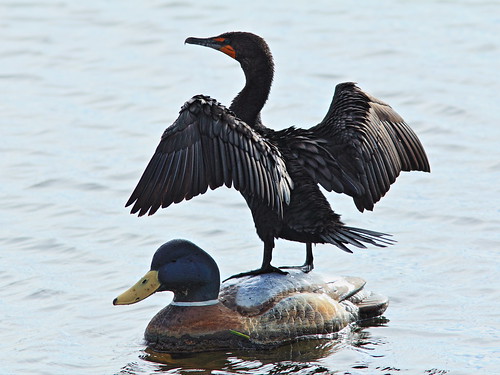
A Wood Stork forages at the water's edge along our lawn:
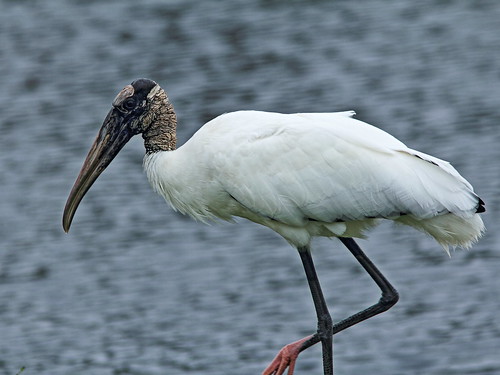
In our back yard, a Red-bellied Woodpecker climbs our Mahogany tree:
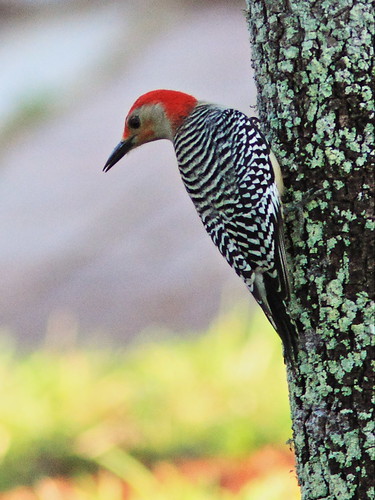
In front of our house, a Northern Mockingbird rests on Saint Francis' head:

On January 30, our Avocado tree is beginning to blossom:
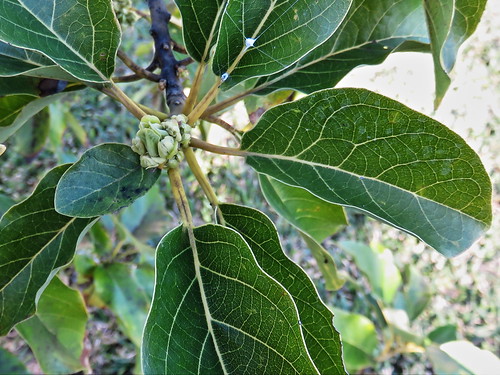
A Monarch butterfly and a Honeybee partake of nectar from our Ixora blooms:

Zebra Heliconian:
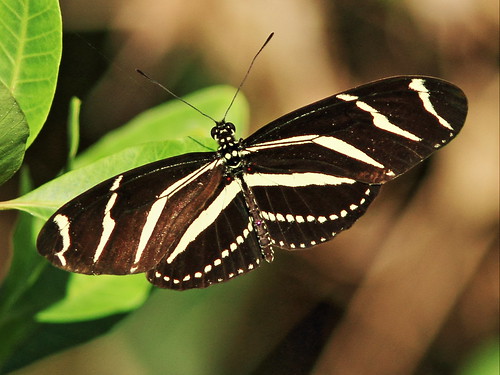 = = = = = = = = = = = = = = =
= = = = = = = = = = = = = = =
Linking to Misty's CAMERA CRITTERS,
Linking to Eileen's SATURDAY'S CRITTERS,
Linking to SKYWATCH FRIDAY by Yogi, Sylvia and Sandy
Linking to WEEKEND REFLECTIONS by James
Linking to BirdD'Pot by Anni
Linking to Our World Tuesday by Lady Fi
Linking to Wild Bird Wednesday by Stewart
Linking to Wordless Wednesday (on Tuesday) by NC Sue
Linking to ALL SEASONS by Jesh
________________________________________________
Please visit the links to all these memes to see some excellent photos on display


































































